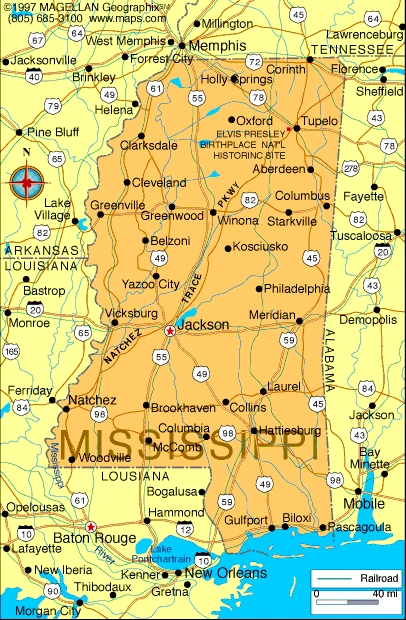Mississippi (river) - Geography.
Publié le 03/05/2013
Extrait du document

Mississippi (river) - Geography. I INTRODUCTION Mississippi (river) (Algonquian Misi sipi,"big water"), river in the central United States, the largest and most important river in North America. The Mississippi has played a central role in the exploration and economic development of the continent, and it is a principal artery for bulk freight, carrying more than any other inland waterway in North America. The Mississippi River system, comprising the Mississippi River and its tributaries, drains 2,979,000 sq km (1,150,000 sq mi). It is the largest drainage system in area in North America and the third largest in the world. Its discharge, which averages 16,800 cu m per second (593,000 cu ft per second), is the sixth largest in the world. The Mississippi River, from Lake Itasca in Minnesota to the Gulf of Mexico, is 3,770 km (2,340 mi) long. However, if the river system is measured from the headwaters of the Missouri River, the Mississippi's longest tributary, to the Gulf of Mexico, its length totals 5,970 km (3,710 mi). II DESCRIPTION During the most recent Ice Age, which ended about 10,000 years ago, glaciers deposited layers of sediment across what is now the upper Mississippi Valley. As the glaciers melted, large quantities of water cut channels through this debris. Today, the upper Mississippi and its tributaries all follow these channels. Farther to the south, the meltwater was joined by the Ohio and Missouri rivers. This great volume of water carved the great channel that now constitutes the lower Mississippi. Now the Mississippi River begins its course at Minnesota's Lake Itasca and flows south through the central United States to the Gulf of Mexico. The Mississippi forms the eastern border of most of Minnesota, Iowa, Missouri, and Arkansas and much of Louisiana; and the western border of most of Wisconsin, Illinois, Kentucky, Tennessee, and Mississippi. Along its course the river is joined by many tributaries, most notably the Illinois River, which connects north of Alton, Illinois; the Missouri River, which connects north of St. Louis, Missouri; the Ohio River, which connects at Cairo, Illinois; and the Arkansas River, which connects north of Arkansas City, Arkansas. At Lake Itasca, the Mississippi is 4 m (12 ft) wide and 0.5 m (1.5 ft) deep. The river is not navigable by commercial traffic north of Saint Paul, Minnesota, because of the Falls of Saint Anthony, a 20 m (65 ft) cascade located there. From Saint Paul to the junction of the Missouri River, the Mississippi is generally 300 to 600 m (1,000 to 2,000 ft) wide, with 29 dams and locks that have been built to provide a navigation channel 3 m (9 ft) deep. In the approximately 320-km (200-mi) stretch between St. Louis and Cairo, large volumes of water and sediment from the Missouri River make the channel muddy and swift flowing. The Ohio River supplies nearly half of the Mississippi's flow, and from Cairo to New Orleans the river is generally 1,000 to 1,600 m (3,000 to 5,000 ft) wide with a navigation channel 3 to 4 m (9 to 12 ft) deep. In this lower course, the river meanders through a floodplain that is 60 to 110 km (40 to 70 mi) wide. Roughly 300 km (200 mi) before it reaches the Gulf of Mexico, the river separates into two branches. At the Old River Diversion, a system of dams, locks, and levees sends about onequarter of the Mississippi's flow to the gulf via the Atchafalaya River. The remainder flows past Baton Rouge and New Orleans before branching in the river's delta into smaller channels, known as distributaries, which enter the gulf. III ECONOMIC IMPORTANCE Many cities and towns began along the Mississippi and continue to depend on the river for their economic base. Dredging and other engineering works in the channel have eliminated many of the hazards of navigation, making it possible for large vessels to use the river. Saint Paul and Minneapolis lie at the northern limit of navigability. Saint Paul rose to prominence as a grain-shipping port, where wheat grown in the northern Great Plains is loaded for shipment south. St. Louis, known as the Gateway to the West, is located near the junction of the Missouri and grew as a port linking the Mississippi with the Great Plains. The portion of the river south of Baton Rouge is navigable by oceangoing vessels, and Baton Rouge and New Orleans are seaports. About 282 million metric tons of freight are carried on the river each year. The most important cargoes on the river are bulk items such as coal, petroleum products, sand, gravel, and grain. The Mississippi Valley has rich alluvial soils, formed by thousands of years of erosion and deposition by the meandering river. The floodplain supports agriculture, especially feed grains and soybeans in the north and cotton, groundnuts, and rice in the south. Abundant in fish, the river is known especially for several varieties of catfish, some of which are harvested commercially. The upper valley once contained vast shellfish beds, which were the basis of an extensive fishery in the 19th and early 20th centuries, but these were severely depleted and are no longer commercially significant. The floodplain includes extensive wetlands, especially in the delta area, which is the largest area of wetlands in the United States. These wetlands form an important habitat for migratory birds. The Mississippi's role as a major artery for the United States extends to waste removal, and the river carries a significant load of both sewage and industrial pollution from urban and rural sources. In 1993 the huge flood of the Mississippi carried toxic chemicals into the river, but most of the spilled substances were diluted to low levels by the flood. In general, pollutant concentrations in the Mississippi are not as high as in some smaller rivers because the volume of water is large. IV HISTORY Numerous Native American groups lived along the banks of the Mississippi. These included the Ojibwa, Winnebago, Fox, Sac (Sauk), Choctaw, Chickasaw, Natchez, and Yazoo. They traded with one another, farmed the floodplains, fished the waters, and gave the river its name. The first Europeans to travel on the river were Spanish conquistadors, such as Hernando de Soto in 1541; French Jesuit missionaries and explorers, such as Louis Joliet and Jacques Marquette in 1673; and French explorer René-Robert Cavelier, Sieur de La Salle, who in 1682 claimed the entire Mississippi Valley for France. The French were the first Europeans to establish settlements in the valley. They founded New Orleans, St. Louis, and several other sites in the early 18th century. European settlement began in earnest between 1780 and 1810. At that time settlers were moving into the Mississippi Valley both from the Ohio River valley, to the east, and from New Orleans, to the south. In 1811 the first steamboat on the river, the New Orleans, ushered in the era of powered shipping. By the 1830s it was cheaper to ship cargo between the lower Ohio Valley and the East Coast via New Orleans than via land routes over the Appalachian Mountains, and commerce grew rapidly. This golden era of steamboats on the Mississippi extended until the 1870s, when railroads surpassed the river as the chief commercial route of the central United States. Barge traffic grew again in the early 20th century, and has risen steadily for specialized bulk cargoes. The Mississippi has flooded several times in recent history. The largest flood recorded in the lower valley occurred in 1927; the largest in the upper Mississippi occurred in 1993. Even before the 1927 flood, a vast system of levees was built in order to limit damage from flooding. These levees protect many areas in the upper valley and virtually wall in the river south of Cape Girardeau, Missouri. These levees have constrained flows in most floods, but in both the 1927 and 1993 floods many levees broke and large areas of floodplain were inundated. Hydrologists believe the floods may have been worsened by the levees, and some of the levees broken in the 1993 flood were not rebuilt. In 2001 the upper Mississippi experienced another large flood that nearly reached 1993 levels. Contributed By: William H. Renwick Microsoft ® Encarta ® 2009. © 1993-2008 Microsoft Corporation. All rights reserved.

«
Contributed By:William H.
RenwickMicrosoft ® Encarta ® 2009. © 1993-2008 Microsoft Corporation.
All rights reserved..
»
↓↓↓ APERÇU DU DOCUMENT ↓↓↓
Liens utiles
- Mississippi (river) - geography.
- Mississippi - geography.
- St. Lawrence (river) - Geography. I INTRODUCTION St. Lawrence (river) (French Saint-Laurent), river
- Amazon (river) - Geography.
- Colorado (river, North America) - Geography.


